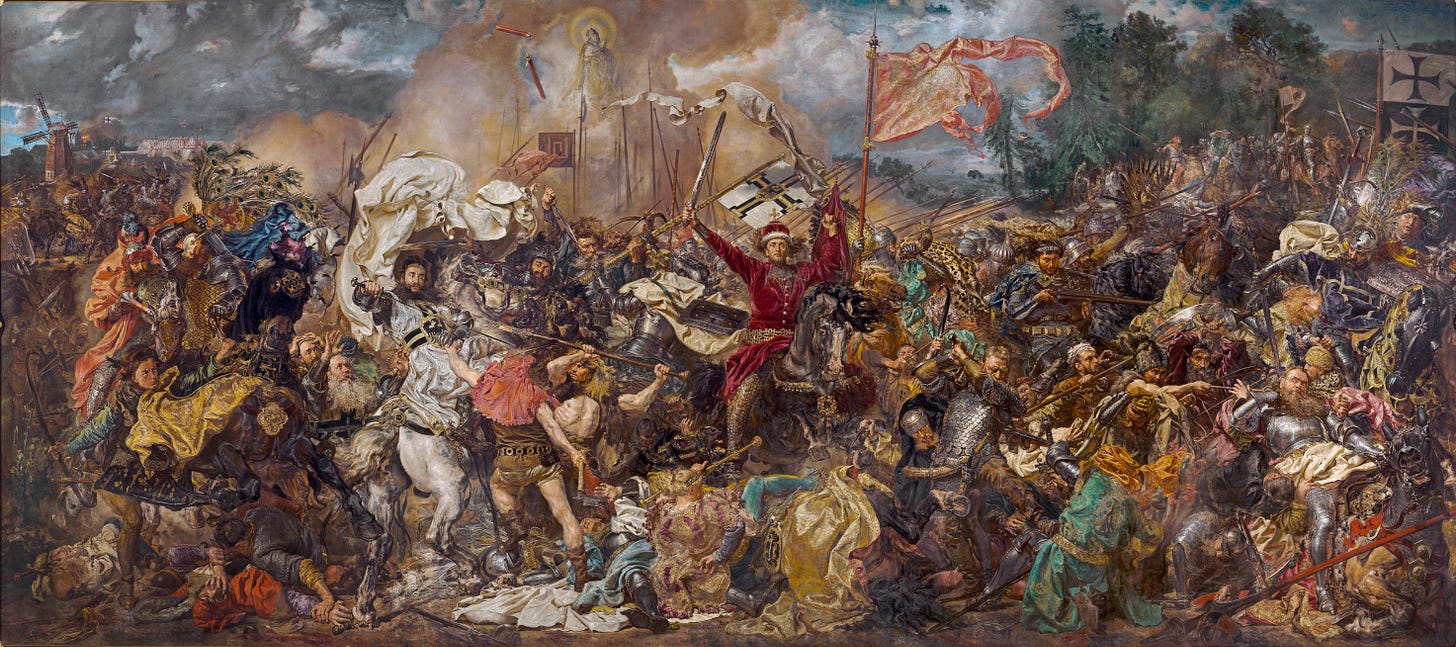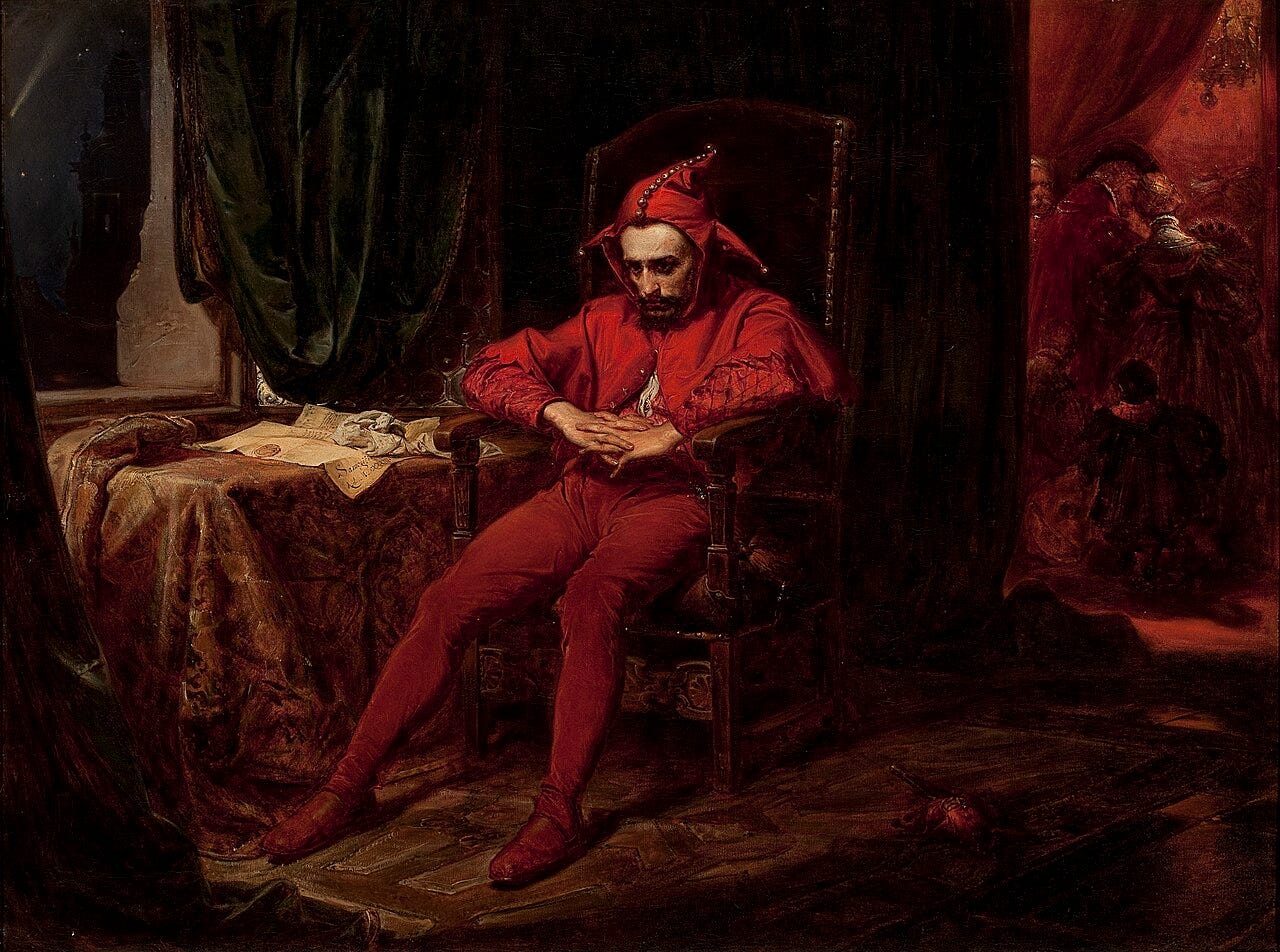For today’s article, I wanted to do a little feature on the work of Jan Matejko. But to really do this man’s work justice, I thought it would be fun to make this a special dual exhibition- bringing together two of his most extraordinary paintings.
_
The first is a stark and solitary masterpiece - imbued with such astonishing emotion, it seems to change the very atmosphere of any room it is hung in.
While the second is big, brash, melodramatic, and crammed with so many characters in the throws of action it can feel almost too overwhelming to even look at!
Yet if there is one thing that both of these vastly different works have in common, it is that they need only a single glance in order to cast an unforgettable spell.

Our first work brings us behind the scenes of an exclusive party - where we find a man taking time to compose himself (or, more specifically, to put down his own guard and to feel the full intensity of his own emotions) away from all those leering eyes in the smoke filled room behind him.
The full title is “Stańczyk during a ball at the court of Queen Bona in the face of the loss of Smolensk”. And for those of you who may not know, Stańczyk himself was one of the most famous court Jesters in Poland during the early to mid 16th century.
Yet as we can see here, the artist has captured this great entertainer in a mood which completely contradicts his Jesters outfit.
From an historical interpretation of the work - we can deduce that our central figure has just learned via that letter on the table that his homeland of Smolensk has fallen into enemy hands during the Muscovite–Lithuanian War.
And, as a result, he has collapsed into this chair of his - overcome with all manner of dread for what may happen now to his home, or to his loved ones, or even to his own life now that he has nowhere left to return to.
But rest assured, we do not necessarily need the full historical context here to connect with the sheer emotion of this work.
In fact, it feels even more profound as a kind of psychological study instead - showing us a man who (to paraphrase Friedrich Nietszche) is “Staring into the Abyss - and having the abyss stare back at him too”.
After all, this is our great entertainer - so famous, so revered, so accustomed to being the absolute centre of attention!
And yet here he is now, choosing to hide away in isolation instead - perhaps feeling an entirely new sense of disgust over the whole vain spectacle he has retreated from.
Thus, I suppose this work is essentially about those moments in life where we no longer feel able to “be”, or to “become” anything - but, rather, we find there is no other choice than to just allow our emotions to truly “become” us.
_
And to some extent, this idea of how internal truth will always find its way to our surface (regardless of any other “mask” we may wear) is also an underlying theme in our second masterpiece too . . . although, in truth, it is hard to believe that this could even be composed the same artist!
Taking us even further back in time here to the 1400s - The Battle of Grunwald is like a history painting on steroids. . . throwing us right into the very heart of action, without a single moment for the reflection or the introspection we find with Stańczyk.
And admittedly, Matejko is supposed to be depicting a story of victory rather than defeat this time - with the Battle of Grunwald being a famous triumph for the allied Kingdom of Poland forces, who were fighting for the second time against their main enemies known as the Teutonic Order.
But once again, I want us to avoid getting too caught up in the historical facts here - and, instead, to notice that familiar air of contradiction in Matejko’s narrative.
You see, his inspiration may be a tale of “victory” . . . but in actual fact, he is trying to show us a much more real side of war here too - vastly different to all those false promises of “glory” or “heroism”.
Hence, the more we survey the faces of his men (no matter whether they are supposed to be allies or enemies) - the more we notice that overwhelming sense of terror and trauma in their eyes too.
_
Clearly, the heat of battle is proving to be more brutal than they could ever have imagined.
And even with our central, flag bearing figure - (intended as the Lithuanian grand duke Vytautas the Great - who, no doubt, has previously been telling all his men how this glorious war will make them immortal in the pages of history!) - still, we see a man who can now no longer hide his own emotion.
Wide eyed, and frozen in utter shock (much like his horse below too) - it is almost as if he didn’t quite realise just what he was signing up for when leading his men into this man-made circle of hell.
Thus, even in the thick of such a chaotic battle . . . our grand duke (and, indeed all of his men) seems somehow just as fearful, and just as uncertain, and just as alone as our great entertainer Stańczyk in the darkness of his dressing room.
Alternatively, for single donations where you can choose your own price - please use the link below.













Wonderful experience reading your writing. What a masterful artist and observant aware human being. Thank you
Thank you, George, for bringing us wonderful works of art and the stories that accompany them.